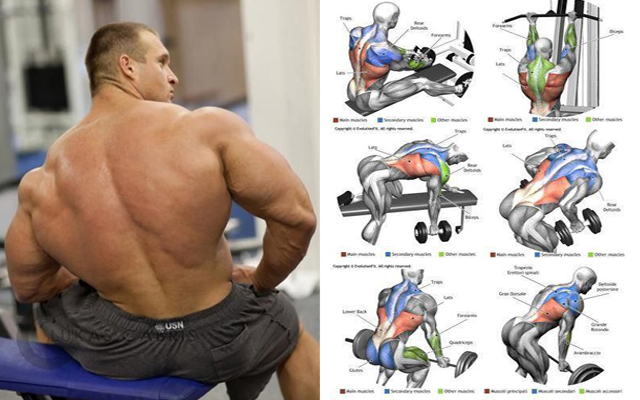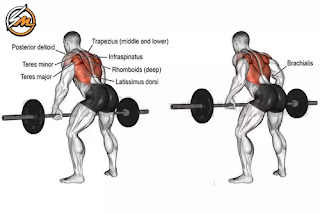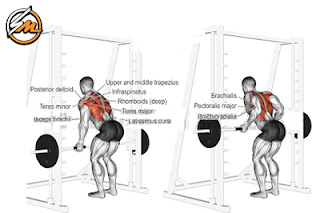Don't know what workouts to do on back day? Take a look at our top ten back builders and get ready to rise!
Knowing which exercises are best for creating a huge, thick back helps speed up the process, which is why we've compiled a list of the top 10 mass-building back exercises.
Based on available research, the difficulty of each action, the amount of muscle each one engages, and how unique each one is in comparison to others, we chose the following ten exercises. This list will also help you figure out where each exercise should go in your program.
1. Barbell Deadlift
This exercise is the best for general backside growth since it targets the entire posterior chain, from the calves to the upper traps. The technique is crucial in the deadlift. You'll work your way up to monster weights that will help you achieve complete strength, release muscle-building hormones, and attract full strength. To assist you to achieve new personal bests, you should employ one of the several deadlift development systems. Stick to the standard deadlift on a back day; other variations, such as the common sumo-style, focus on muscles other than the back.
To keep your muscles fresh, start with deadlifts if you're doing a rigorous workout (sets of less than 6 reps). If you're doing deadlifts with repetitions, you should do them later in your workout.
2. Bent-Over Barbell Raw
This is the second-best back movement in terms of pure weight you can lift. Bent-over barbell rows target the upper and lower back's larger muscular groups, making them an excellent overall back builder. Like the deadlift, this is a difficult maneuver that requires a perfect form.
Near the start of your back workout, do bent-over rows for hard sets in lower rep ranges, such as 6-8 to 8-10. The Smith variation is an excellent option since it puts you in the vertical plane, but it requires you to align your body properly with the bar. Because the bent-over barbell row places a greater lumbar strain on your lower back than many other back exercises, it's best to do it early in your workout to help your lower back.
3. Wide-Grip Pull-Up
Pull-ups with a wide grip are excellent for working the upper lats. A tighter grip may provide a longer range of motion, but the wide-grip pull-up may be able to load to a greater degree due to the optimized starting joint position. The greatest challenge for most trainers is training to failure in the proper rep range for improvement, which is 8-12 reps. If you do pull-ups early in your workout, you'll need to utilize a weighted belt. If you're experiencing trouble, turn to a wide-grip pull-down, which is a decent alternative, or use an aided pull-up system or a skilled spotter.
In this case, it's critical to keep proper form. The scapula should be retracted before initiating the pull (pull the shoulder blades down and into each other). During your workout, you should: Because the range of motion for pull-ups is so wide, numerous light reps serve as effective shoulder warm-ups. Because the form is so important, pull-ups should be moved to the top of the workout to guarantee proper shoulder-joint alignment.
4. Standing T-Bar Row
You'll gain a lot of weight here, but it'll usually come at the expense of your knees and hips. For some people, maintaining a flat back can be challenging, therefore the sponsored version is a safer option. Keep your knees bent at an angle the entire time because these aren't squats. Normally, you'll be able to select from a variety of hand placements and widths. A larger hold will aid the lats, while a neutral grip will benefit the middle back (rhomboids, teres, and traps). This is undoubtedly one of the most straightforward activities to locate.
Do this in the first half of your practice session. Concentrate on the stretch and contraction of the back. If you're a seasoned lifter, go for 25 reps instead of 45, and protract your scapula at the bottom of each rep to increase your range of motion. Do this in the first half of your practice session. Concentrate on the stretch and contraction of the back. If you're a seasoned lifter, go for 25 reps instead of 45, and protract your scapula at the bottom of each rep to increase your range of motion.
5. Wide-Grip Seated Cable Row
Using a wide grip on a lat bar is a nice change of pace because it targets the upper lats more. Broad rows are similar to some back machines, but you shouldn't combine the two in your workout unless you make some changes to the grip or rep range. You could even rotate your handle and head around shoulder-width apart to target the lower lats more effectively and bring your elbows closer to your arms. During your workout, you should: Ropes, like robots, should be finished at the end of your session. Choose a weight that allows you to complete no more than 12 reps.
6. Reverse-Grip Smith Machine Row
As the elbows draw in closer to your sides, reverse-grip actions imply two things: the biceps become more significant, and the lower region of the lats becomes the aim. You can concentrate solely on lifting as much weight as possible because you don't have to worry about balancing the Smith engine. Bend down around 45 degrees, sticking low to the pole, and expect a little help from your hips and knees when you're pounding out the hard sets. The Smith machine has a fixed acceleration plane, and being able to truly manage a weight (imagine four seconds up and four seconds down) is both innovative and disheartening.
In your training, you don't require more than one reverse-grip exercise. Do it around halfway through the exercise when doing the strong overhand pulls. Wrist braces should be used at some time throughout your back exercise.
7. Close-Grip Pull-Down
Because the wide-grip pull-up is too similar to the wide-grip pull-up we already safeguarded, we chose the close-grip handle for our pull-down. A near-neutral grip has the same effect on the lats as a regular hold, but you don't lose any muscle fibers. A tighter grip, like pull-ups, allows for a wider range of motion and longer time under stress for the lats, which is beneficial to muscle development. In your workout: This movement can be utilized as a warm-up for your shoulders, but it's ideally suited for sets of 8-12 reps at the end of your workout or as a mass-building exercise.
8. Single-Arm Dumbbell Row
This is a great solo workout for lifting a lot of weight with each hand working separately. You'll have more range of motion and won't be limited if the vulnerable side falls first if you practice unilaterally. By placing one hand on a table, you can assist with the support of your lower back. Allowing a tiny amount of trunk rotation can also aid in the activation of some of the "core" muscles. In your workout: Unless you purposely flare your elbow out high, this movement focuses on your lower lats. Sets of 10-12 reps can be done anywhere in the workout, from the beginning to the end.
9. Decline Bench Dumbbell Pull-Over
Pullovers on top of each other? Without a doubt! This one appears to be very similar to the straight-arm cable pull-down you're used to. Because this is a single-joint pass, it encourages you to concentrate on your lats and torch them. When compared to a flat bench, the declining variety puts more stress on the lats, allowing for a wider range of motion. Before dumping the weight on the floor behind you, be sure it clears your brain. Single-joint actions should almost always come second in your body-part schedule when exercising. For a good ending pump, stick to a rep range of 12-15 for each package.
10. Single-Arm Smith Machine Row
Pullovers on top of each other? Without a doubt! This one appears to be very similar to the straight-arm cable pull-down you're used to. Because this is a single-joint pass, it encourages you to concentrate on your lats and torch them. When compared to a flat bench, the declining variety puts more stress on the lats, allowing for a wider range of motion. Before dumping the weight on the floor behind you, be sure it clears your brain. Single-joint actions should almost always come second in your body-part schedule when exercising. For a good ending pump, stick to a rep range of 12-15 for each package.
Related article: 7 Effective Exercises to Strengthen Your Back















0 Comments